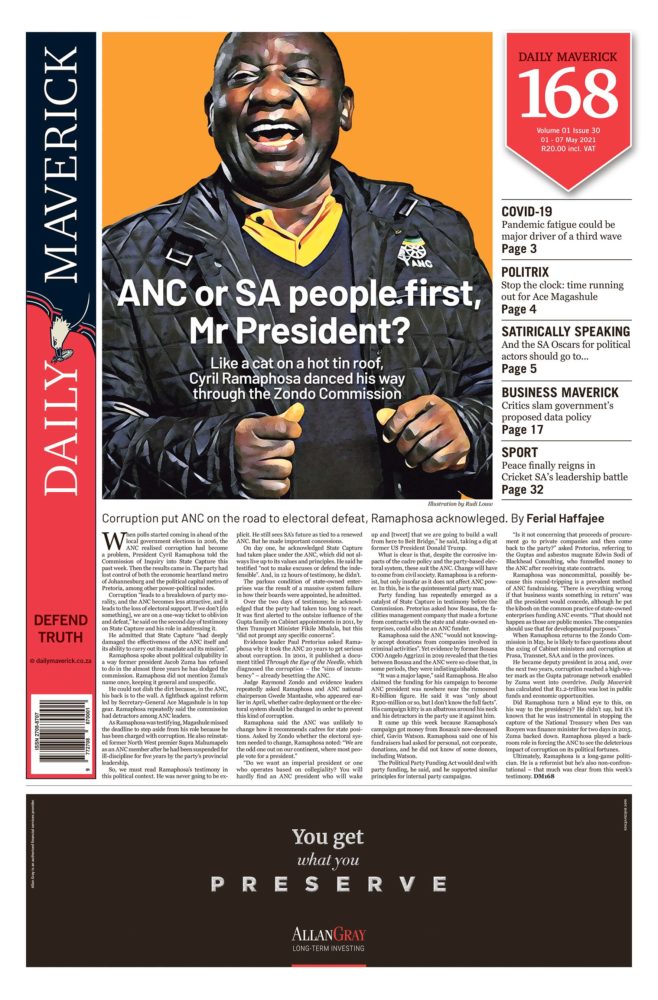First published in the Daily Maverick 168 weekly newspaper.
One may be tempted to dismiss the burgeoning sport of kite-boarding as a pastime of the wealthy, but it’s the fastest-growing sport in the world, is enjoyed by the likes of Richard Branson and Barack Obama – and South Africa is uniquely positioned to benefit.
The combination of wind, beach and waves means the strip of coast between Blouberg and Milnerton in Cape Town is the busiest kite-boarding beach in the world.
The sport generates more than R480-million a year.
Taken collectively, ocean sports, which includes surfing, surf ski, stand-up paddleboarding, sportfishing and scuba diving industries, generate revenues of R1.4-billion a year, largely in the Western Cape, according to research in 2018 by the University of Cape Town. Not bad for an industry made up entirely of small businesses, but it could be better.
A new initiative called BlueCape plans to capitalise on South Africa’s natural coastal beauty and provide support to businesses and investors in the ocean economy to remove barriers and catalyse growth.
Founded by the V&A Waterfront and the City of Cape Town, among others, the intention is to unlock value in the ocean economy by focusing on three key marine industries: marine manufacturing, ocean sports and superyachts.
“We learnt the benefits of organising a sector from the marine manufacturing sector, which we organised under an export council some 20 years ago,” says Bruce Tedder, one of the founders of BlueCape. When an industry is fragmented, it has no voice, no collective marketing muscle or collective problem-solving skills.
For instance, there are well-paying jobs available for deckhands on sportfishing boats, but no deckhands. “You need someone who can handle the fishing, identify seabirds and chat to guests, but there is no training for this. We will work with life-saving clubs or sportfishing associations to connect the dots. We are the enabler.”
The government, local and national, is willing to provide support, but it cannot respond to the needs of 50 small organisations, Tedder says.
South Africa’s boatbuilding industry is well established and is worth in the region of R2.2-billion a year. In particular, South Africa has a global reputation for catamaran building and the country is ranked second after France in terms of units produced.
This is largely driven by one builder, Robertson & Caine, which produces more than 220 boats a year in the luxury catamaran sector and employs 1,700 people. Other smaller builders produce between one and 10 boats a year. Another contributor to the sector is Southern Wind Shipyard, which manufactures high-end super-yachts that retail for about R270-million each.
“Our intention is not to create another Southern Wind or Robertson & Caine – these are massively capital-intensive industries. Rather, we want to focus on the secondary manufacturers associated with the boatbuilders. The sailmakers, for instance, are world-class. There is no reason they should not be making sails for Danish or French boats.”
Roughly 15 to 20 superyachts call in at Cape Town and other South African ports a year, and the opportunity to service this market is also one that BlueCape plans to target.
“There are seismic shifts taking place in the world of superyachts,” says Tedder. “Billionaire owners of superyachts are younger and more adventurous than previously and are no longer content with sailing around the [Mediterranean]. For instance, Google founder and superyacht owner Larry Page is an avid kitesurfer, while his wife Lucinda Southworth is an excellent surfer. These kinds of people want to go off the beaten track.”
Supporting this trend is the fact that expedition-style yachts are being built, which can handle trips as far afield as Alaska. This puts Cape Town, with its abundance of leisure activities, squarely on the route map.
Cape Town can be both a destination and a service provider to these yachts, Tedder says. “If you are going to sail off the beaten track, crews will need specialised training and Cape Town is equipped to provide this.”
To support this industry the V&A Waterfront will invest about R250-million developing its Quay #7 for superyachts, as it has done with the cruise liner terminal.
The Waterfront, in collaboration with BlueCape, is also exploring the feasibility of developing an “ocean economy hub” that could provide a physical space for all three BlueCape focus sectors.
“We envisage that this hub will provide a dedicated innovation, event, skills development, networking and co-working space for the marine manufacturing sector and other sectors of the blue ocean economy,” says V&A Waterfront CEO David Green.
The BlueCape partnership will be working with national and provincial governments, organisations such as Wesgro and Invest Cape Town, as well as industry bodies and organisations over the three marine industries. DM168
Cape Town’s Surfing Sector by Numbers
- 150 surf-related organisations
- R200-million – size of surf retail sector
- 50,000 surf lessons take place in a year
- 4,000 surfboards shaped a year
- 200 ecoboards shaped a year
Cape Town’s Kitesurfing Sector by Numbers
- R480-million – kitesurfing and windsurfing sector in Cape Town
- 15,000 kitesurfing tourists visit Cape Town each year
- R60,000 to R140,000 – average spend of kitesurfing tourists
- 80,000 kitesurfing lessons a year in Cape Town and Langebaan
- 70% of lessons given to tourists
- 1,500 local kitesurfers in the Cape Town area
This story first appeared in our weekly Daily Maverick 168 newspaper which is available for free to Pick n Pay Smart Shoppers at these Pick n Pay stores.



















Lets hope BlueCape realises that what they propose requires a cleaner ocean, especially on the Milnerton/Blouberg side. The Salt River is one of the filthiest little rivers in the Cape, and the lagoon is so sewerage-poisoned you can’t even put a toe in it. Lagoon beach is unsafe to swim. Get to it!